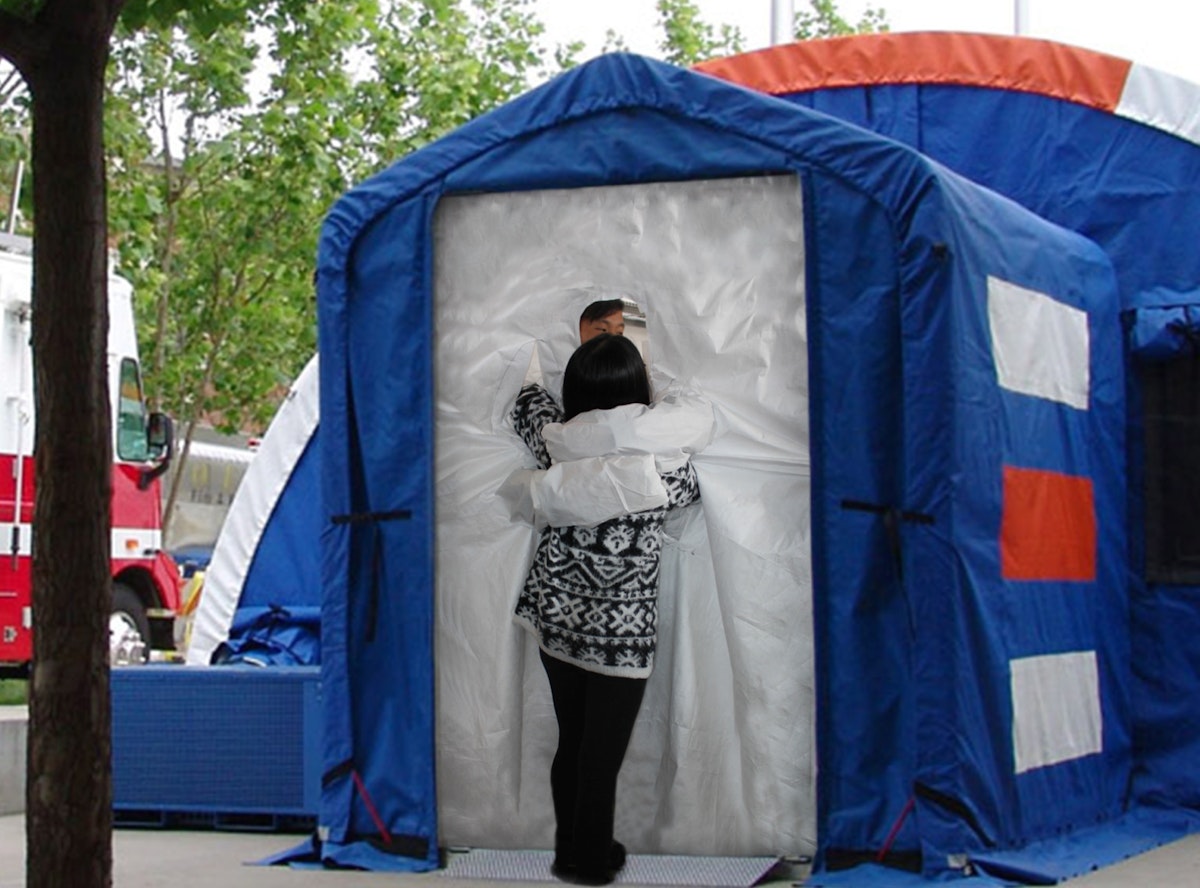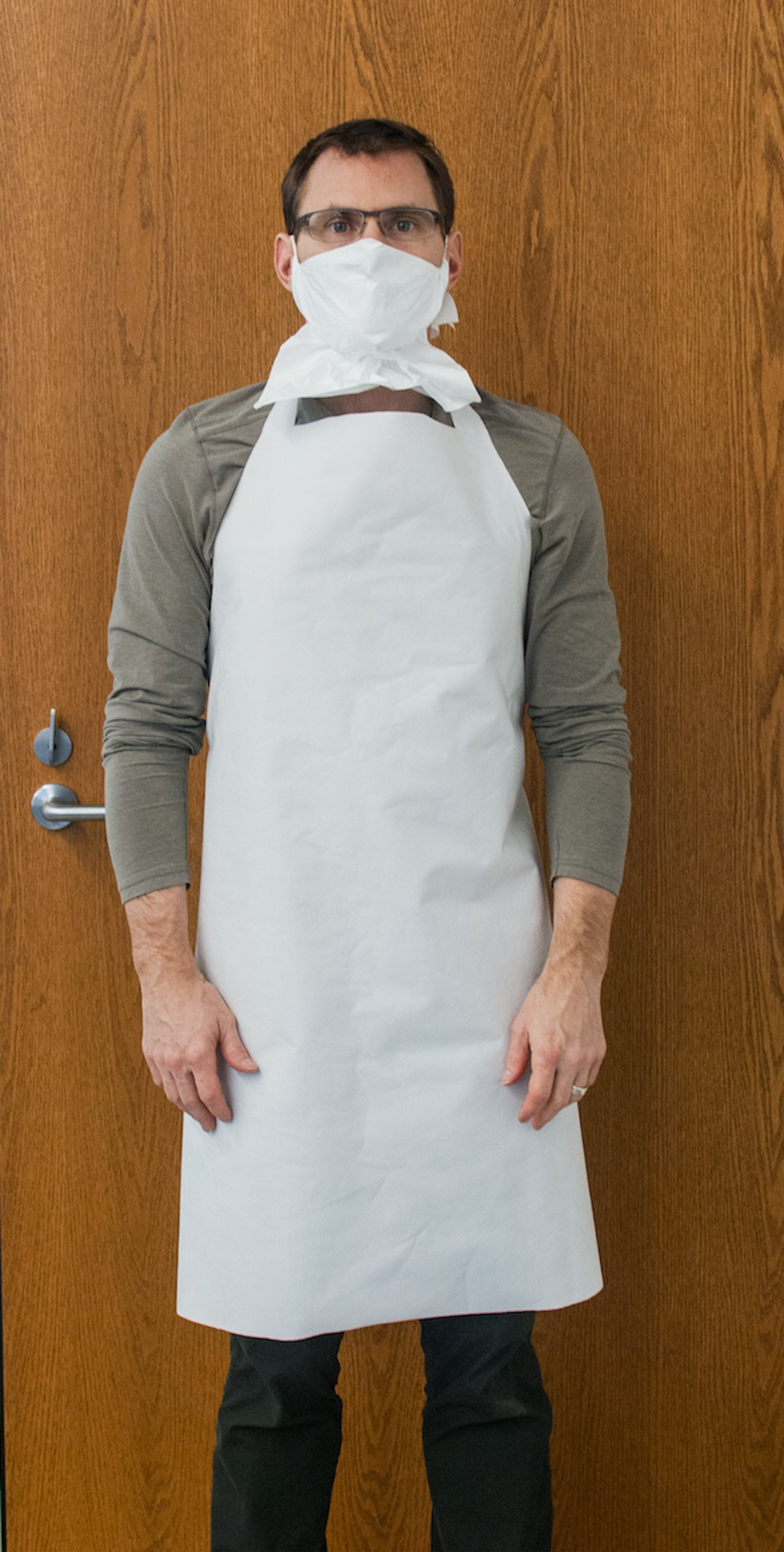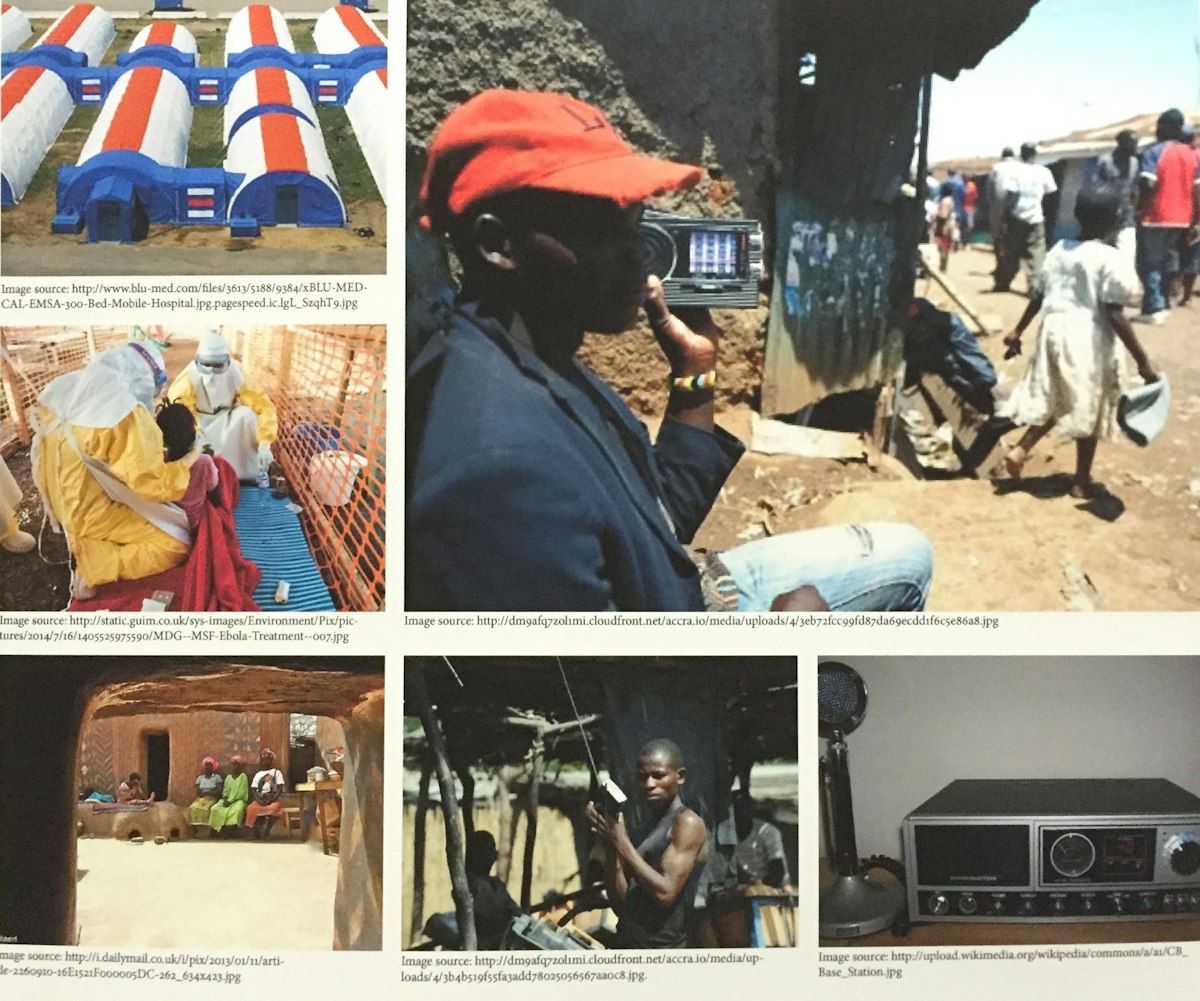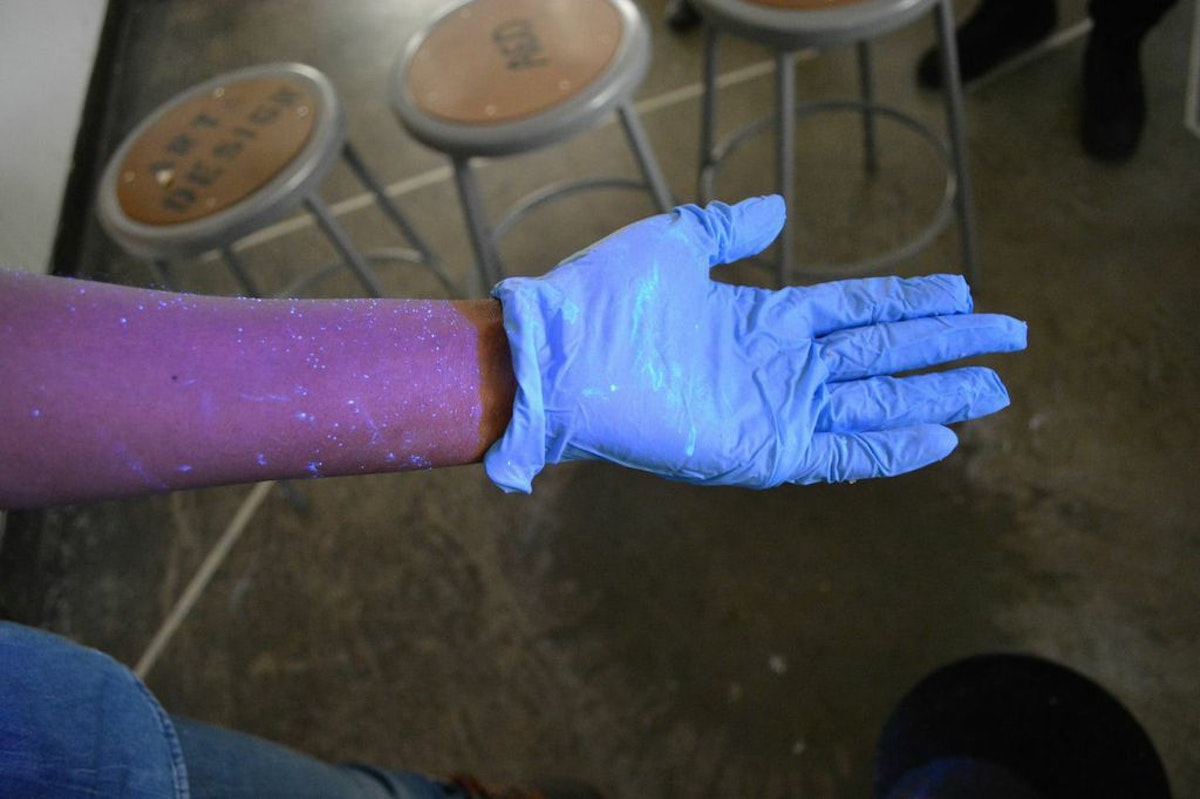Addressing Ebola Through Design
A recent multi-disciplinary design charette hosted by the Stamps School of Art & Design brought together professionals, faculty and students from across the university to address a timely and critical global issue. The challenge: to generate innovative design solutions specific to the Ebola outbreak.
Working in interdisciplinary teams for three days of intensive conceptualizing, designing and making, the charette participants produced a wide array of smart, often deceptively simple, inventions for improving procedures around Ebola healthcare – from glove removal devices, to an Ebola survivors radio program, to a way to allow an actual physical embrace between a caregiver and a patient.
A guiding principle for the charette was “empathy,” a challenge that became a key component in the design process.
The charette focused on three main themes:
- design of personal protection equipment
- health communication across cultural and linguistic barriers
- transportation of infected and diseased bodies
Outcomes from the charette will be shared with the all interested parties and are available below. For a full list of projects and for more information on how the designs are being refined and employed, contact Jan-Henrik Andersen.
“This event was a powerful example of how to leverage the amazing knowledge and skills that exist across campus. It shows how U-M can provide students with a compelling experiential learning experience that simultaneously benefits society at large.”
- Joshua Botkin, Entrepreneur in Residence at Ross School of Business
The Projects
Project: Visor/Garment, Straps, Glove Remover
Design Problem: Improving Personal Protective Equipment
Team:
Joshua Botkin, M-PED, ZLI, Ross School of Business
Jennifer Holmes, UMHS Emergency Department
Sanghyun Lee, Stamps School
Alex Sobolev, Stamps School BFA ‘08
Robert Self, School of Engineering
Addresses:
Protective suits fit only a small number of body types, and removing the suits and gloves often leads to rips and tears that expose healthcare workers to contaminating fluids. Suits are also expensive and difficult to obtain in poorer areas. After prototyping a number of designs, the team developed several simple solutions.
Design Solutions
Disposable Doffing Strap
Other groups in the charette have developed full suits that significantly improve the doffing process with smart improvements on the standard protective suit. However, in poorer West African areas in the heart of the Ebola crisis, these suits are expensive and less attainable for field use. This team designed a disposable doffing strap which would be as inexpensive as pennies per piece and allow for a much safer doffing process.
The Visor-based Personal Protective Equipment Garment
Many developing countries have vibrant infrastructures for repairing, repurposing, and reusing materials and mechanisms. The Visor-based Personal Protective Equipment (PPE) is a system that fits into this environment and can be used, reused, and modified as necessary by the community. Put together as a complete kit, it can be a complete solution for a PPE garment that fits a wide variety of body sizes. Provided as a solo visor, any tarp or waterproof material can be converted into an emergency PPE suit.
Glove Removal
In order to protect themselves, healthcare workers dealing with Ebola often wear two pairs of gloves. However, there is currently a high risk that healthcare workers’ inner gloves and/or skin will be contaminated during the glove removal process. Accordingly, we have developed a disposable sticker that can be manufactured cheaply, distributed easily throughout both the developed and developing worlds, and attached to any glove to facilitate its safe removal. The sticker is attached to the inside surface of the glove at the wrist before it is donned. When the wearer wishes to doff the glove, she bends the sticker inward; this creates a space inside the glove that allows the wearer to grasp the outer glove without touching the sleeve or inner glove -- thereby avoiding the transfer of viral matter to those surfaces.
Inner glove removal during the doffing process poses a high risk of contaminating the bare skin with viral matter. We developed an ergonomic inner glove removal tool designed to be reusable, sanitizable in bleach or alcohol, non-puncturing, lightweight and inexpensive. This tool could be mass produced and it's use could prevent skin contact with viral matter present on glove finger tips; normally a concern during the doffing process without a removal tool.
Project: The Embrace
Design Problem: health communication across cultural and linguistic barriers
Team:
Robert Adams, Taubman College
Hyunsoo “Brad” Bang, Stamps School
Deirdre Golden, MD, JD, University of Detroit Mercy Law School
John Hetrick, Stamps School, BFA ‘93
Allie McGuire, Stamps School
Caroline Marin, Stamps School
Yichi Zhang, School of Information
Addresses:
When someone shows symptoms of Ebola and is taken for treatment and tests positive, they are torn from their families, isolated in quarantine, and unable to say goodbye. How can we lessen the anxiety and fear associated with Ebola treatment and the patient’s abrupt isolation? How can we maintain a connection with family? How can we solve the most basic human need that Ebola steals … the ability to be touched and comforted?
Design Solution:
The Embrace is a large fabric panel that allows a hug between an infected and non-infected person. The panel is made of dual layers of protective material with four offset sleeves and a viewing window.
Notes from the team:
Our discussion centered around relieving the anxiety and fear associated with Ebola treatment-- in particular, the devastating patient drop off point and long walk up an orange-fenced maze to a tent filled with suited health aides. We thought through the possibility of immune survivors acting as escorts and advocates for people seeking treatment. We considered whether those advocates could accompany the villagers into the testing tent where they could communicate with healthcare workers through a glass window. Addressing the need for lab draws to be done for testing, we thought there could be two portals in the glass. At that point, we associated the way neonatal infants are treated in the incubator stage in the NICU and how parents could touch their infants through those windows. If there could be safe portals for doctors to touch patients, could there also be portals for patients to touch their family?

Project: Transformative Tyvek
Design Problem: Improving Personal Protective Equipment
Team:
Kelly Sadlon, Stamps School
Jeff Xu, Stamps School
Eljon Elezi, School of Engineering
Hea Juan Oh, School of Nursing
Bruce Tharp, Stamps School
Rachel Boswell, Landscape Architecture, Stamps BFA ‘10
Addresses:
Protective suiting is an issue, both for healthcare workers and for villagers caring for infected family members at home. The majority of transmissions occur when family members, friends, and loved ones are caring for the ill or burying the deceased.
Design Solution:
Transformative Tyvek is a one-sheet answer to multiple needs, providing a do-it-yourself means to create protective wear and assist in the hygienic handling of fluids and bodies. Inexpensive to produce and easy to ship, the Tyvek sheet is printed with both patterns and directions to create a variety of protective gear: a bed sheet, vomit container, apron, mask, and body bag.
Notes from the team:
“Our approach is not limited to our suggested uses, and is applicable to variable contexts and conditions. Ultimately it enables the resourcefulness of the users to tailor their own solutions to this disease.”

Project: Ebola Survivors Radio
Design Problem: health communication across cultural and linguistic barriers
Team:
Pam Falk, Registered Nurse
Corinne Lee, School of Nursing
Erin Mullins, Stamps School
Carolyn Rodgers, Stamps School
Stacy Skekloff, Stamps School/ School of Engineering
Addresses:
There is a lack of trust between healthcare workers and villagers and there are very few effective communication tools in the villages, and a lack of closure when a family member is lost to Ebola, Additionally, Ebola survivors are treated as outcasts when they return from treatment.
Design Solution:
The Ebola Survivors Radio Program disseminates important information that is usually difficult to get due to lack of transportation and phones. Increased communication between healthcare workers and villagers will help build trust and lessen fears of treatment and hospitals. This radio program can also be a platform for survivors and family members of those affected to share their stories and create better understanding of the treatment process, as well as celebration and acceptance of survivors within the community. This radio program could be an addition to the radio system West African communities already use.
Notes from the team:
Batteries and old radios could be donated to West African villages to make the radio program even more accessible.

Project: Improvised Personal Protection Protocol for a Domestic Setting
Design Problem: health communication across cultural and linguistic barriers
Team:
Terence Harp, Stamps School
Amy Kamden-Wandji, Stamps School and International Studies
Frank Pelosi, Skyline High School
Sonia Tagari, Stamps School
Kat Hartman, Stamps School MFA ‘08
Addie Langford, Tech Shop Detroit
John Marshall, Stamps School
Hannah Smotrich, Stamps School
Addresses:
Common bodily fluid clean-up protocols are based on the presence of dedicated personal protective equipment, access to clean water and the ability to dispose of waste safely. There is a need for education on how to clean up bodily fluids at home, without spreading the disease.
Design Solution:
We developed a guide for household members in low resource situations where everyday items could be used to limit the risk of contamination while caring for and cleaning up after a loved one at home. We created a graphic rubric to prevent virus transmission among household members, close contacts and caregivers of Ebola patients. We conceived this as a “stop, drop, and roll” (a simple fire safety technique taught as a component of safety training) for dealing with bodily fluids.
